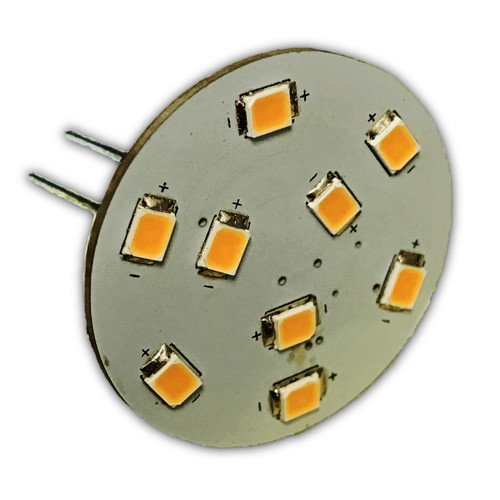DIMMING THE OVERHEAD DINETTE LIGHTS
Follow-up to the several previous posts (starting with above) on the topic...
Recently I noticed marinebeam.com has a back-pin G4 LED disc with built-in dimmer:

 store.marinebeam.com
store.marinebeam.com
Sure enough, they seem to work for our purposes. The earlier 10-LED disc we had installed over the dinette is rated at 150 lumens.
These new 9-LED discs are rated at 180/120/60 lumens, so the upper setting is slightly brighter and the lower two settings are both dimmer. All 9 LEDs light up first, then an OFF/ON at the switch changes them to 6 LEDs, then another OFF/ON changes them down to 3 LEDs.
The dimmest setting (60 lumens) isn't exactly as dim as you'd normally think of lights on a dimmer circuit, but its a good improvement. And the brightest setting (180 lumens) complements the 12-LED discs (170 lumens) that we have installed over the galley.
-Chris
DIMMING THE OVERHEAD DINETTE LIGHTS?
Has anyone tried that?
We have dimmers on one set of our saloon lighting, and on one of the light sets over the galley. Both of those sets are AC circuits with low-voltage converters somewhere along the way... and the light fixtures take the same 24VDC LEDs we've used on the DC lighting everywhere else. The dimmers on these circuits are Vimar Idea-series #VM16557 available from Imtra.
Product Search | Marine Products & Accessories | Imtra
Vimar Marine Switches | Cover Plates & USB Outlets | Imtra
The two lights over the dinette are 24VDC... and I don't find a Vimar dimmer compatible with 24VDC circuitry, let alone one from their Idea series that we have throughout our boat.
I also don't know where the low-voltage converter is in the AC circuit... but presumably it happens somewhere before the dimmer? Which means the dimmer would receiving 24V? 24V-ish? Would that be 24VDC or 24VAC? Or...?
How's that AC-to-low-voltage thing work? I've read AC dimmers and DC lighting aren't compatible, but... how did Sea Ray get there from here?
EDIT: Actually, I've only guessed that the low voltage is 24VDC. Our LEDs are rated for 10-30VDC, so I guess it those dimming light fixtures could be 12V instead of 24V.
Ideas? (sort of a pun...)
-Chris
Follow-up to the several previous posts (starting with above) on the topic...
Recently I noticed marinebeam.com has a back-pin G4 LED disc with built-in dimmer:

9-LED Back Pin G4 LED Bulb with Sequential Dimming
Replacement LED G4 bulb with step dimming capability without existing dimmer 12vdc 24vdc compatible warm white light high efficiencySure enough, they seem to work for our purposes. The earlier 10-LED disc we had installed over the dinette is rated at 150 lumens.
These new 9-LED discs are rated at 180/120/60 lumens, so the upper setting is slightly brighter and the lower two settings are both dimmer. All 9 LEDs light up first, then an OFF/ON at the switch changes them to 6 LEDs, then another OFF/ON changes them down to 3 LEDs.
The dimmest setting (60 lumens) isn't exactly as dim as you'd normally think of lights on a dimmer circuit, but its a good improvement. And the brightest setting (180 lumens) complements the 12-LED discs (170 lumens) that we have installed over the galley.
-Chris



